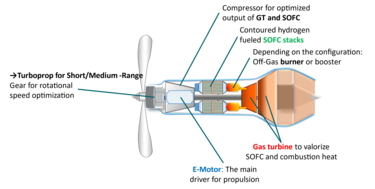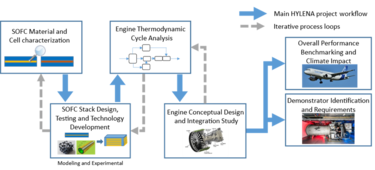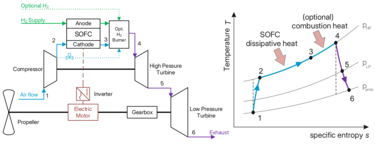HYLENA
HYdrogen eLectrical Engine Novel Architecture
Project description
HYLENA will investigate, develop and optimize an innovative, highly efficient integrated hydrogen powered, electrical aircraft propulsion concept for short and medium range. It will achieve significant climate impact reduction by being completely carbon neutral with radical increase of overall efficiency.
The full synergistic use of (infographic 1):
- an electrical motor (as the main driver for propulsion),
- a contoured hydrogen fueled SOFC stacks (geometrically optimized for nacelle integration),
- a gas turbine (to thermodynamically integrate the SOFC),
will act as an enabler for hydrogen aviation and will allow for efficient and compact engine concepts. This disruptive propulsion system will be called the HYLENA concept.


HYLENA aims to evaluate and demonstrate the feasibility of a “game changing” engine type which integrates Solid Oxide Fuel Cells (SOFC) into a turbomachine, in order to utilize the heat generated by the fuel cells on top of its electrical energy. The combination of e-motor, turbomachine and contoured SOFCs fueled with H2 will deliver higher overall efficiency and performance compared to state-of-the-art turbofan engines. Indeed, HYLENA Figures of Merit consist of CO2 emission; negligible NOX and an unmatched overall efficiency state-of-the-art turbofans which corresponds to an outstanding performance increase. It will also enable to extend the flight range for the same fuel tank size.
The HYLENA project will deliver:
- On SOFC cell level: Experimental investigations on SOFC cell technologies and identification of the most promising one(s) for aeronautical applications;
- On SOFC stack level: Studies and tests to determine the most compact/ light/ manufacturable way of stack integration;
- On thermodynamic level: Cycles simulations of the proposed novel HYLENA concept architecture and down selection of the most performing one;
- On engine design level: Exploration, through resilient calculation and simulation, of the best engine design, sizing and overall components integration;
- On overall engine efficiency level: Demonstration that HYLENA concept can reach very high efficiency levels with limited weight and complexity;
- On demonstration level: A decision dossier for a potential ground test demonstrator to prove that the HYLENA concept works in practice during a second phase in the continuity of this project.

The challenge of current engine overall efficiency
CHALLENGE
Air traffic growth inevitably causes the increase of aviation's combustion emissions, hence aggravating aviation's environmental and societal impact, locally and globally. In numbers, civil aviation is responsible for around 3.5% of the total anthropogenic greenhouse effect evaluated by the effective radiative forcing.
Current commercial aviation engines have relied on kerosene combustion turbomachine (Turbofans and Turboprops) technologies for the last 70 years with a maximum 40% overall efficiency. And the carbon footprint of Kerosen has a significant impact on the climate
On the contrary, Hydrogen based electric aviation has the potential to revolutionize the aviation industry and offers a decarbonized energy alternative to traditional fossil fuels. This project aims to deliver a breakthrough solution for this societal and scientific challenge.
Using a Next Generation Fuel Cell Differently
SOLUTION
When we are talking about Hydrogen based electric aviation, we are generally talking about hydrogen fuel cell power an electrical engine
In the State of the Art Low Temperature Fuel Cell, electricity is produced by Proton Exchange Membrane fuel cell (PEM-FC) with an efficiency of ~60%, which means that 40% of the chemical energy supplied in form of hydrogen and air is released as heat.
With HYLENA, we propose a new Architecture that combines high temperature Solid Oxid fuel cell (SOFC) and gas turbine (GT) advantages to take benefit of both electricity and thermal energy.

The electric power of the SOFC is used to power an electrical motor driving a propeller or a fan, and the heat produced is valorized into a turbine thanks to the Brayton cycle. Thus, this architecture has many advantages:
- There is no need for a big thermal management system, the turbomachine is being self-cooled.
- The heat extracted in the Low Pressure turbine is turned into mechanical power that adds up to the power from the e-motor driven by the fuel cells
- The geometric flexibility enables now to consider the full integration of the SOFC harmoniously into a new generation engine gondola.
Finally, the HYLENA engine concept will provide in the future a lighter and more efficient Engine than its Low Temperature Fuel Cell Electric equivalent.
The potential radical improvements that could be expected
BENEFITS
The HYLENA project will be first to address an hydrogen powered combined e-motor-SOFC-GT engine concept in aircraft applications.
The expected benefits we expect with this new concept are the following ones:
- High overall efficiency engine: Expected Overall efficiency (> 65%) versus existing Turbofan (~38%)
- Fuel flexibility: SAF, Natural Gas, Hydrogen or Ammonia for SOFC
- Geometric flexibility for SOFC stack design: Advanced geometries enable integration into more compact mobile applications (e.g. Urban Air Mobility)
- Simple architecture and Light Weigh Fuel Cell engine: more simple architecture and control without heavy electrical wirings
- Gravimetric Power density on stack level: > 3-5 kW/kg





